OSAMA BIN LADEN
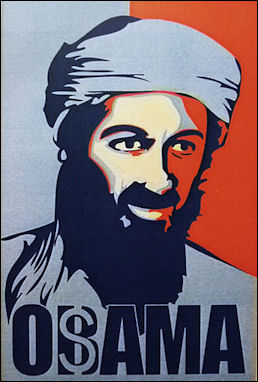
Osama bin Laden founded Al-Qaida, the international Muslim extremist group, and acted as its mascot and spiritual leader. A Saudi from one of the world’s richest families, he initially made a name for himself fighting with the mujahidin in Afghanistan. He was known among his followers as “the Sheik,” “the Prince,” “the Emir” and the “the Director.”
Osama bin Laden was 6 feet 5 inches (1.9 meters) tall. Lanky and thin, he had high cheekbones and an unkept beard, a style favored by Muslims who believe that the Prophet Mohammed had a similar style bead. He was often photographed wearing an turban tied like the early followers of the Prophet Mohammed and donned Afghan-style cloths. He often had a Kalashnikov by side or in his hand. Within his family he was regarded as a black sheep.
In the United States, Osama bin Laden has been viewed almost exclusively as a terrorist and a leader of a terrorist organization. The Bush administration called him as vermin to be “smoked out.” In the parts of Arab and Muslim world has been viewed as a freedom fighter and religious and political leader.
Ben Macintyre of The Times wrote: “Bin Laden is the foremost ogre of the first decade of the 21st century, a symbol of horror to the West, an icon of defiance to some Islamists, a pin-up, a fugitive and a killer. His face is possibly more widely known than any other on the planet, yet he remains elusive, unrepentant...the evil Pimpernel. Although the so-called war against terror has evolved dramatically in the last decade, he remains the poster boy for terrorism, a convenient shorthand for all that is violent and fanatical in Islam.
John-Thor Dahlburg and Alex Rodriguez wrote in the Los Angeles Times: Osama bin Laden, a scion of one of Saudi Arabia's wealthiest families, became the grim apostle of a strain of Islamic radicalism that exalted violence against non-believers, and the leader of a terrorist network that launched repeated attacks in the West, most spectacularly in the U.S. on Sept. 11, 2001....He became a figure of worldwide influence as a supporter of Muslim freedom fighters in Afghanistan in the 1980s and, later, as an organizer and financier of terrorist cells who concealed his whereabouts, living in safe houses, remote camps and even caves in Sudan, Afghanistan and Pakistan. [Source: John-Thor Dahlburg and Alex Rodriguez, Los Angeles Times May 2, 2011]
Yossef Bodansky, a terrorism expert who wrote a biography of Bin Laden, labeled him "the man who declared war on America." For former President George W. Bush and countless Americans, he was simply "the evil one." Yet for a time, he was also a hero to many in the Muslim world, an avenger akin to Saladin, the sultan who drove the Christian Crusaders from Jerusalem more than eight centuries ago. Although the United States has long had enemies in the Arab world, none blended the traditional Muslim doctrines of holy war and martyrdom, a Pan-Islamic message and a loathing for the West and its way of life, with such devastating effect.
Kate Zernike and Michael T. Kaufman wrote in the New York Times: “Osama bin Laden...was a son of the Saudi elite whose radical, violent campaign to recreate a seventh-century Muslim empire redefined the threat of terrorism for the 21st century. With the attacks on the World Trade Center and the Pentagon on Sept. 11, 2001, Bin Laden was elevated to the realm of evil in the American imagination once reserved for dictators like Hitler and Stalin. He was a new national enemy, his face on wanted posters. He gloated on videotapes, taunting the United States and Western civilization. Long before, he had become a hero in much of the Islamic world, as much a myth as a man — what a longtime C.I.A. officer called “the North Star” of global terrorism. He had united disparate militant groups, from Egypt to the Philippines, under the banner of Al Qaeda and his ideal of a borderless brotherhood of radical Islam. Terrorism before Bin Laden was often state-sponsored, but he was a terrorist who had sponsored a state.” [Source: Kate Zernike and Michael T. Kaufman, New York Times, May 2, 2011]
Eugene Robinson wrote in the Washington Post: “No one could match his charisma, and no one could match his legend: He fought the Soviets in Afghanistan and lived to tell the tale; he dealt an unprecedented blow to America in the heart of its biggest city; he escaped, like a ghost, after U.S. forces had cornered him at Tora Bora; and he managed to elude the soldiers and spies of the world’s pre-eminent superpower for nearly a decade. The myth of his invincibility helped draw recruits to al-Qaida and gave veterans a reason to soldier on.” [Source: Eugene Robinson, Washington Post , on May 12, 2011]
David Remnick wrote in The New Yorker: “Bin Laden, as medieval ideologist and global terrorist, had a record of accomplishment that was as vast as it was hideous. He did more to slash the fabric of American life than anyone since the Second World War. His capacity to arouse the fevered imaginations of young fundamentalists led to the murder of thousands of men, women, and children — among them Muslim men, women, and children — in Aden, Mogadishu, Nairobi, Dar es Salaam, Washington, New York, Shanksville, Bali, Madrid, London, Baghdad, Kabul, and Marrakech. He provoked wars. He forced the rise of expensive structures of security and surveillance. He incited a national politics of paranoia and retribution. He did as much as the economic rise of China and India has done to undermine America’s short-lived post-Cold War status as a singular, self-confident, seemingly omnipotent superpower. “[Source: David Remnick, The New Yorker, May 16, 2011]
Books: There are Osama bin Laden biographies by Adam Robinson and Yossef Bodansky. Peter Bergen’s two books on bin Laden include “The Osama bin Laden I Know: An Oral History of al Qaeda's Leader” (Free Press). Peter Bergen is a Schwartz senior fellow at the New America Foundation who has written extensively about bin Laden. “The Bin Ladens: An Arabian Family in the American Century” by Steve Coll (Penguin Press, 2008) is very good. “Ghost Wars: The Secret History of the C.I.A., Afghanistan, and Bin Laden, from the Soviet Invasion to Sept. 10, 2001" by Steve Coll (2004) won the Pulitzer Prize
Osama bin Laden’s Character
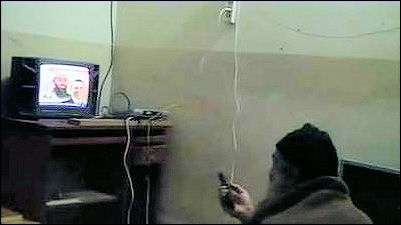
Osama bin Laden watching himself
on TV at his compound in Pakistan Osama bin Laden has been described as shy, gentle, quiet and scholarly. He often thought for up to a minute before he spoke and spent a great deal of time alone, studying, praying and reading, or least giving the impression that he was doing so. He is not known for having much of a sense of humor. Bin Laden was also regarded as a shrewd organizer, a courageous fighter and a master at manipulating the media. He spoke Arabic, English and French.
In Afghanistan and Pakistan bin Laden wore a traditional “shalwar kameez” (baggy trousers and long shirt) and praised go in almost every sentence. He lived simply and ascetically and brushed his teeth with mishwak sticks. Even so, according to the book "Growing Up Bin Laden," by two of his sons, bin Laden nearly always kept a tape recorder nearby to take down his thoughts, plans and musings about politics and the world.
While promoting her 2004 book “Inside the Kingdom” Carmen bin Ladin, former wife of Osama’s older half-brother, portrayed bin Laden as being so committed to his beliefs he would deny a water bottle to his own infant son in the middle of the Saudi desert if there was a religious reason for doing so. She also insisted that “it’s certainty possible” that Osama retained ties to the [Saudi] royal family.
Noman Benotman, a Libyan former jihadist who knew bin Laden in Sudan, told Peter Bergen, bin Laden lived a life far removed from that of the average billionaire’s son: “He’s living a normal life, the life of poor people. I saw him many times. You see his kids”you will never, ever in your life think those kids are bin Laden’s kids; [rather] they are people from the poorest family in the world. I saw them. You wouldn’t believe it”they’re kids running around in old clothes. He always tells his followers, “You should learn to sacrifice everything from modern life, like electricity, air-conditioning, refrigerators, gasoline. If you are living the luxury life, it’s very hard to evacuate and go to the mountains to fight.” [Source: Peter Bergen, Vanity Fair, January 2006]
Peter Bergen wrote in the Washington Post: “When bin Laden’s followers have described their feelings for him, it has been with love. Abu Jandal, a Yemeni who became one of bin Laden’s bodyguards, described his first meeting with bin Laden in 1997 as “beautiful” and said he came to look on him “as a father.” Shadi Abdalla, a Jordanian who was also one of bin Laden’s bodyguards, explained his boss’s attraction: “A very charismatic person who could persuade people simply by his way of talking. One could say that he “seduced” many young men.” [Source: Peter Bergen, Washington Post , June 17, 2011]
Osama bin Laden’s Interests: Horses, Poetry, and Stuffed Zucchini
One of his great passions was thoroughbred horses. He rode since his teens and brought horses with hime as well as wives and children when he moved from Saudi Arabia to Sudan. Even in his late 40s, he boasted of riding up to 40 miles a day. Bin Laden's first wife said that his favorite dish was zucchini stuffed with marrow.
Bin Laden was a poet. Some have described him as a good one. Some of his poems were written in the classical Arabic found in the Koran. A poem called “The Travail of a Child Who Has Left the Land of Holy Shrines” goes: “Why father, have they sent these missiles, thick as rain/ showing mercy neither to child, nor to a man shattered by old age.”
Bin Laden’s imagery often harks back to the 12th century, when blood dripped from the swords of Muslim fighters clashing with Christian crusaders. Flagg Miller, a linguistic anthropologist at the University of California at Davis, told the New York Times, “His poetry is didactic, always with a political message, but sometimes very moving.” One a tape released after U.S. President Barack Obama was elected bin Laden wrote: “And over hellfire growing middle aged/ Clothed in raiment of sadness that never leave them. [Source: Rod Nordland, New York Times, June 6, 2009]
Osama bin Laden, Soccer and Judo
Osama bin Laden is said to have been a big soccer fan. When he toured Europe with his family he reportedly became an Arsenal supporter, though there is no record of his ever having been to a match at Arsenal’s home field of Highbury. In early 1994, according to one story, bin Laden spent three months in London. In between meetings with bankers and supporters, the story goes, he went watch the Arsenal four times and bought gifts for his sons from the club’s souvenir shop. Bin Laden purportedly was deeply impressed by the passion of the English soccer fans and is heard talking about dreams with soccer player pilots with fiends in Al-Qaida video tapes. Arsenal fans have acknowledged the Al-Qaida leader’s support in a 2002 chant that went: “He’s hiding near Kabul/ He loves the Arsenal/ Osama/ Oh oh oh oh.”
In May 2011, Reuters reported that bin Laden studied judo while in Saudi Arabia. Jimmy Wu, a judo coach, told Reuters he came across bin Laden when coaching the Saudi Arabian national judo team from 1981 to 1991. Osama bin Laden stood out not just because of his height but because of his serious, conservative demeanour. [Source: Reuters, May 9, 2011]
Bin Laden, whom Wu then knew only as "Osama", attended classes at the judo centre while still a university student. He was too tall for judo, and Wu said he advised him against the sport, but he was insistent so Wu accepted him. "I didn't know the name bin Laden then," Wu said. "After 9/11 I was invited to a seminar, and some of my former students there said 'oh Jimmy, Osama, now he's our hero'. I was surprised and I looked for some pictures and I said 'oh this guy' and I started to have some memory of him."
Wu showed Reuters photographs of himself and a tall, thin, bearded, serious young man with a mop of black hair whom he said was Osama. Osama attended lessons two to three times a week but Wu never saw him again after 1984. Wu remembered an occasion when his wife came to find him at the judo centre. She had wanted to go shopping and Wu was late. "She came into the centre and most of the students weren't bothered, some smiled, but one really tall guy came to me and said 'who is that?'" Wu replied that it was his wife. "The tall one said 'this is the centre, no women should be in here'. He did not approve. I have a particular memory of this. That was Osama."
Image Sources: Wikimedia Commons except Osama bin Laden at 16 from Time magazine at Osama bin Laden in Oxford from Carmen bin Ladin, former wife of Yeslam bin Ladin, Osama’s older half-brother, from her 2004 book, Inside the Kingdom
Osama Bin Laden, Terrorism and Al-Qaida
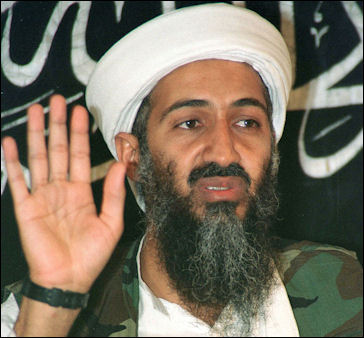
Osama founded al-Qaeda soon after the Soviets withdrew from Afghanistan in 1988. John-Thor Dahlburg and Alex Rodriguez wrote in the Los Angeles Times: “In Afghanistan, Bin Laden found valuable new human assets and allies, including dozens of exiled Egyptian extremists who became a key part of Al Qaeda's expanding core. These associates included Ayman Zawahiri, founder of the Egyptian Islamic Jihad, and Mohammed Atef, a former policeman who was its military commander.The merger of Al Qaeda and Egyptian Islamic Jihad created a terrorist force of great ambition and destructive power. [Source: John-Thor Dahlburg and Alex Rodriguez, Los Angeles Times May 2, 2011]
“Bin Laden worked assiduously to unify the numerous and diverse radical Islamic movements under Al Qaeda's banner, exploiting his reputation, money and charm to draw other leading figures. In addition to supporting Al Qaeda with contributions from what was left of his personal fortune, Bin Laden funded the group through criminal enterprises such as drug trafficking and extortion and money skimmed from legitimate Islamic charities. In 1998, along with Zawahiri and extremists from Pakistan and Bangladesh, he issued the fatwa in the name of the "International Islamic Front for Jihad against Jews and Crusaders" that called killing Americans and their allies was a sacred duty for Muslims.” New York Times
Kate Zernike and Michael T. Kaufman wrote in the New York Times, Al Qaeda became the infrastructure for his dream. Under it, he created a web of businesses — some legitimate, some less so — to obtain and move the weapons, chemicals and money he needed. He created training camps for his foot soldiers, a media office to spread his word and even “shuras,” or councils, to approve his military plans and his fatwas. Through the 1990s, Al Qaeda evolved into a far-flung and loosely connected network of symbiotic relationships: Bin Laden gave affiliated terrorist groups money, training and expertise; they gave him operational cover and furthered his cause. Perhaps the most important alliance was with the Taliban, who rose to power in Afghanistan largely on the strength of Bin Laden’s aid, and in turn provided him refuge and a base for holy war. [Source: Kate Zernike and Michael T. Kaufman, New York Times, May 2, 2011]
In 1996, American officials described Bin Laden as “one of the most significant financial sponsors of Islamic extremism in the world,” but he was not thought of as someone capable of orchestrating international terrorist plots. When the United States put out a list of the most wanted terrorists in 1997, neither Bin Laden nor Al Qaeda was on it. Bin Laden, however, demanded to be noticed. In February 1998, he declared it the duty of every Muslim to “kill Americans wherever they are found.” After the bombings of two American embassies in East Africa in August 1998, President Clinton declared Bin Laden “Public Enemy No. 1.”
See Separate Article FOUNDING AND EARLY HISTORY OF AL-QAIDA factsanddetails.com; EARLY AL QAIDA ATTACKS: SOMALIA, AFRICAN EMBASSY BOMBINGS AND USS COLE ATTACK factsanddetails.com
Osama bin Laden and Aymen al-Zawahiri
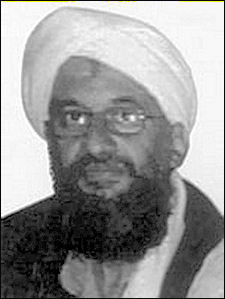
Dr. Ayman al-Zawahiri is believed to have been connected with Osama bin Laden since 1985, when the two men met in Pakistan during the Afghanistan War. Zawahiri is credited by some with making bin-Laden an Islamic radical with a global agenda. Fluent in English, he sometimes acted as an interpreter for bin Laden. Peter Bergen wrote in Vanity Fair: For bin Laden, the slightly older, cerebral Zawahiri must have presented an intriguing figure. Zawahiri had first joined a jihadist group at 15 and had recently served three years in Egypt’s notorious prisons for his jihadist activities. For Zawahiri, bin Laden was on his way to becoming a genuine war hero, and his deep pockets were well known. In 1987, Zawahiri set up his own jihad group, which was soon supported by bin Laden. [Source: Peter Bergen, Vanity Fair, January 2006]
Lawrence Wright, “Each man filled a need on the other. Zawahiri wanted money and contacts...Bin laden, an idealist given to causes, sought direction. Zawahiri, a seasoned propagandist, supplied it...For Zawahiri, bin Laden was a savior — rich and generous, with nearly limitless resources, but also pliable and politically unformed.”
Wright wrote in The New Yorker: “Osama bin Laden, who was based in Jidda, was twenty-eight and had lived a life of boundless wealth and pleasure. His family's company, the multinational and broadly diversified Saudi Binladin Group, was one of the largest companies in the Middle East. Osama was a wan and gangly young man and was by no means perceived to be the charismatic leader he would eventually become. He lacked the underground experience that Zawahiri had and, apart from his religious devotion, had few settled beliefs. But he had been radicalized by the Soviet invasion of Afghanistan in 1979, and he had already raised hundreds of millions of dollars for the mujahideen resistance. [Source: Lawrence Wright, The New Yorker, September 16, 2002]
"Bin Laden had followers, but they weren't organized,"Essam Deraz, an Egyptian filmmaker who made several documentaries about the mujahideen during the Soviet-Afghan war, told Wright. "The people with Zawahiri had extraordinary capabilities — doctors, engineers, soldiers. They had experience in secret work. They knew how to organize themselves and create cells. And they became the leaders." "Bin Laden had an Islamic frame of reference, but he didn't have anything against the Arab regimes," Montasser al-Zayat, an Islamist lawyer told Wright. "When Ayman met bin Laden, he created a revolution inside him."
Deraz observed that bin Laden had become dependent on Zawahiri's medical care. "Bin Laden had low blood pressure, and sometimes he would get dizzy and have to lie down," Deraz told Wright. "Ayman came from Peshawar to treat him. He would give him a checkup and then leave to go fight." Deraz recalls that, during one of the most intense battles of the war, he and the two men were huddled in a cave near Jalalabad with a group of fighters. "The bombing was very heavy," Deraz said. "Bin Laden had his arm stretched out, and Zawahiri was preparing to give him glucose. Whenever the doctor was about to insert the needle, there was a bombing and we would all hit the ground. When the bombing stopped for a while, Zawahiri got up and set up the glucose stand, but as soon as he picked up the bottle there would be another bombing. So one person said, 'Don't you see? Every time you pick up the bottle, we are bombed.' And another said, 'In Islam, it is forbidden to be pessimistic,' but then it happened again. So the pessimistic one got up very slowly and threw the glucose bottle out of the cave. We all laughed. Even bin Laden was laughing."
See Separate Articles AYMAN RAI AL-ZAWAHIRI'S LIFE BEFORE AL-QAIDA factsanddetails.com ; AYMAN RAI AL-ZAWAHIRI AND AL-QAIDA factsanddetails.com
Osama bin Laden’s View of America
Bin Laden had a deep antipathy for America. Nasser al Bahri, who served as bin Laden's personal bodyguard for six years, told Newsweek, bin Laden used to amuse himself by chanting this bit of doggerel, part of a longer poem by a jihadist poet: ““I am the enemy of America/ Till this life is over and doomsday comes./ It’s the root and trunk of destruction,/ It’s the evil on the branches of trees.” "The only thing that seems to rile him up is mention of America," Bahri said. "I think from the very beginning of his childhood he hated America. I don't know why. He won't even drink a Pepsi." [Source: Newsweek, September 3, 2007]

Osama bin Laden at nine Steven Coll wrote in the Washington Post: Since the late 1980s and certainly since 1991, bin Laden has seen the United States as the principal invader of the Muslim world because of its support for the Saudi royal family, Israel and other Middle Eastern governments he labels apostate. In often tedious debates with comrades during the 1990s, he has argued that only by attacking distant America could al Qaeda hope to mortally wound the Middle East's frontline authoritarian governments. [Source: Steven Coll, Washington Post, February 2005]
Bin Laden regards the United States as decadent, corrupt, weak and vulnerable. He saw the American retreat ib Somalia as a sign of weakness and views American society and culture as immoral. He objects to democracy and elections as being western creations and exercises in which man exerts his will over others — playing God in the view of many Muslim extremists — and prefers that Muslim be governed b Islamic law. He told CNN in 1997: The United States “wants to occupy our countries, steal our resources, impose agents on us to rule us and then wants us to agree to all this. If we refuse to do so, it says we are terrorists. When Palestinian children throw stones against the Israeli occupation, the U.S. says they are terrorists. Whereas when Israel bombed the United Nations building in Lebanon while it was full of children and women, the U.S. stopped any plan to condemn Israel. At the same time that they condemn any Muslim who calls for his rights, they receive the top official of the Irish Republican Army at the White House as a political leader. Wherever we look, we find the U.S. as the leader of terrorism and crime in the world.” [Source: Kate Zernike and Michael T. Kaufman, New York Times, May 2, 2011]
John-Thor Dahlburg and Alex Rodriguez wrote in the Los Angeles: “Just after Sept. 11 attacks, Bin Laden issued a personal declaration of war against the United States and its allies from a man on the run who had come to believe that his faith and the Western world could not coexist. Like President Bush, Bin Laden proclaimed that whoever was not with him was his enemy. "These events have divided the world into two camps, the camp of the faithful and the camp of the infidel," he said. "Every Muslim must rise to defend his religion."[Source: John-Thor Dahlburg and Alex Rodriguez, Los Angeles Times May 2, 2011]
Osama bin Laden Focus on Killing Americans

Nairobi bombing in 1998 On August 23, 1996, Osama bin Laden issued an edict entitled "Declaration of War Against the Americans Occupying the Land of the Two Holy Places." “Muslims burn with anger at America,” it read. The presence of American forces in the Persian Gulf states “will provoke the people of the country and induces aggression on their religion, feelings, and prides and pushes them to take up armed struggle against the invaders occupying the land.” The imbalance of power between American forces and Muslim forces demanded a new kind of fighting, he wrote, “in other words, to initiate a guerrilla war, where sons of the nation, not the military forces, take part in it.” [Source: Kate Zernike and Michael T. Kaufman, New York Times, May 2, 2011]
In this lengthy statement, published in the London newspaper Al-Quds al-Arabi, bin Laden boldly lays out his case against the Saudi ruling family and its American backers. "Everyone agrees that the shadow of a stick cannot be straightened as long as the stick is crooked," he writes. "Hence, it is imperative to focus on attacking the main enemy." He argues that the West deliberately divided the Muslim world into "states and mini-states," which could be easily controlled. He declares, "There is no higher priority, after faith, than pushing back the American-Israeli alliance." He calls upon all Muslims to participate in jihad in order to liberate Saudi Arabia and restore the dignity of the Islamic community. "In view of the enemy's strength, fast and light forces must be used and must operate in absolute secrecy."[Source: Lawrence Wright, The New Yorker, September 16, 2002]
The United States and its allies did not remove its troops from the Persian Gulf region. “So we tell the Americans as a people,” Osama bin Laden told ABC News, “and we tell the mothers of soldiers and American mothers in general that if they value their lives and the lives of their children, to find a nationalistic government that will look after their interests and not the interests of the Jews. The continuation of tyranny will bring the fight to America, as Ramzi Yousef and others did. This is my message to the American people: to look for a serious government that looks out for their interests and does not attack others, their lands or their honor.” [Source: Kate Zernike and Michael T. Kaufman, New York Times, May 2, 2011]
In February 1998, Osama bin Laden issued the edict calling for attacks on Americans anywhere in the world, declaring it an “individual duty” for all Muslims. On August 7, 1998, the eighth anniversary of the United States order sending troops into the gulf region, two bombs exploded simultaneously at the American Embassies in Nairobi, Kenya, and Dar es Salaam, Tanzania. The Nairobi bomb killed 213 people and wounded 4,500; the bomb in Dar es Salaam killed 11 and wounded 85.
The United States retaliated two weeks later with strikes against what were thought to be terrorist training camps in Afghanistan and a pharmaceutical plant in Sudan, which officials contended — erroneously, it turned out — was producing chemical weapons for Al Qaeda. To call us Enemy No. 1 or Enemy No. 2 does not hurt us,” he said. “Osama bin Laden is confident that the Islamic nation will carry out its duty.” "We believe that the biggest thieves in the world and the terrorists are the Americans," Bin Laden said in a February 1999 magazine interview. "The only way for us to fend off these assaults is to use similar means. We do not worry about American opinion or the fact that they place prices on our heads."
Osama bin Laden’s Strategy and View of Terrorism and the World
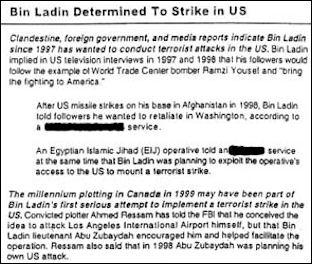
Determined to strike America Osama bin Laden and his supporters have not thought of themselves as terrorists; they have regarded themselves as pious Muslims acting according to princeps laid out in the Koran and other Islamic texts. Many of the principals that are are dear to people in the West — democracy, tolerance and women’s rights — are anathema to them. Their activities in their mind are practical and rational not the insane schemes of a James Bond villain.
Joshua Teitelbam, an Israeli scholar at Tel Aviv University told the Washington Post, Osama bin Laden “looks at the world in very stark black-and-white terms. For him, the U.S. represents the forces of evil that are bringing corruption and domination into the Islamic world, particularly Saudi Arabia, the holiest land in the world to Muslims.”
Many analysts believed that Osama bin Laden’s true ambition was to cause disaffected Muslims to rise up and take power in Saudi Arabia and other Muslim country and ultimately make him leader of the Muslim world as a modern-day caliph. They also argued that he wanted money and power that went along with the title.
John Brennan wrote in the Washington Post: “Terrorism, in bin Laden's strategy, is only a tactic, a means to achieve what he believes is a providentially ordained objective — global domination by an Islamic caliphate. Yet dangerously, the United States is focusing on countering that tactic, missing the growth of the extremist Islamic forest as we flounder among the terrorist trees. Maybe it's because we have led ourselves to believe that the term "al Qaeda" means "Kill Americans." It doesn't. It means "foundation" or "base" in Arabic. Bin Laden chose the word intentionally and cleverly. He knew that his battle-hardened core of veterans from the Soviet-Afghan war of the 1980s would serve only as the foundational wellspring to irrigate fields of political, social and economic discontent among the Muslim masses.” [Source: John Brennan, Washington Post, March 1, 2006, Brennan spent 25 years in the CIA and is the former head of the National Counterterrorism Center and the Terrorist Threat Integration Center, ]

“He also recognized that the global explosion of mass media outlets over the last decade gave al Qaeda a ready recruitment vehicle. Headline-grabbing violent attacks against the West, especially the United States, broadcast by al-Jazeera, CNN or the BBC — and abetted by instantaneous Internet communication — were certain to impress and win adherents. Bin Laden has also insidiously convinced us to use terminology that lends legitimacy to his activities. He has hijacked the term "jihad" to such an extent that U.S. and other Western officials regularly use the terms "jihadist" and "terrorist" interchangeably. In doing so, they unwittingly transfer the religious legitimacy inherent in the concept of jihad to murderous acts that are anything but holy.
Addressing the question of Osama bin Laden’s views about freedom, Peter Bergen wrote in the Washington Post: “He didn’t seem to care very much about the beliefs of the “crusaders.” His focus was invariably on U.S. foreign policy in the Middle East.In a review of 24statements made by bin Laden from 1994 to 2004, political scientist James L. Payne found that 72 percent of the content of the speeches referred to alleged Western or Jewish attacks against Muslims, while only 1 percent criticized American culture or way of life. In a 2004 video, bin Laden directly rebutted Bush’s assertions about al-Qaeda’s motivations for attacking the United States: “Contrary to what Bush says and claims — that we hate your freedom. If that were true, then let him explain why did we not attack Sweden.”[Source: Peter Bergen, Washington Post, May 6, 2011]
Noman Benotman, who fought alongside al-Qaeda in Afghanistan in the early 90s, told Bergen: “Bin Laden is driven by his tactics, not strategy — the tactics have taken over the strategy. It’s always about just kill, shoot, destroy, bomb, in Afghanistan, in Iraq; now it’s in America, in Europe. You can’t talk to these people. It’s killing, shooting, sacrificing. My point of view is bin Laden himself and his group will achieve nothing. They will fail to achieve what they are asking for, and bin Laden, his credibility, it’s decreasing, not increasing. What has been increasing is this kind of new tactic — the suicide attacks.”
Osama bin Laden as a Religious Authority
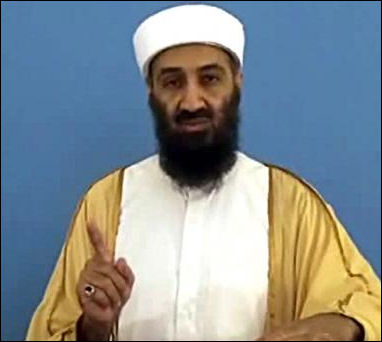
John-Thor Dahlburg and Alex Rodriguez wrote in the Los Angeles Times: In February 1998, at a terrorist training camp in Afghanistan, Osama bin Laden and other hard-line leaders announced the creation of the International Islamic Front for Jihad Against Jews and Crusaders. In its first religious edict, the front declared that "to kill Americans and their allies, both civil and military, is an individual duty of every Muslim who is able, in any country where this is possible." [Source: John-Thor Dahlburg and Alex Rodriguez, Los Angeles Times May 2, 2011]
Osama bin Laden does not the theological training to issue fatwas, especially ones that go against Islamic teaching. In the words of the American Taliban John Lindh, “Osama bin Laden can’t issue fatwas. He is neither an intellectual nor a religious authority.” The killing of civilian is strictly prohibited by Islamic law. The Koran states: “Fight in the cause of God those who fight you but do no transgress limits, for God loves not the transgressor.”
The grand imam at Al Azhar mosque, regarded by some as the no. 1 religious authority in Sunni Islam told the Washington Post, “Osama bin Laden is no specialist in religious affairs. Islamic law banished anyone who issues an untrue fatwa.
Meetings and Lectures with Osama bin Laden
One Indonesian man told the Washington Post he met Osama bin Laden four times in Afghanistan and said bin Laden showed him and other recruits videos of Palestinian civilians dying after Israeli attacks. “Osama was crying and said, “These people are my brothers in Islam. They ask for my help and your help,”
Osama bin Laden gave lectures at the Al Farooq jihadist training camp in Afghanistan. Describing one of his lectures there the American Taliban John Lindh told The New Yorker, “To tell you the truth he was really boring. I was so tired. The training was grueling. I thought he seemed sick. Most of the speakers stood up when they spoke, but he sat down, and he talked in this really soft voice about the history of Afghanistan, and how everyone had invaded it starting with the Greeks. I listened to the beginning, but it wasn’t very interesting. So I fell asleep.” Lindh said met once with bin Laden. He said he remembers little from the encounter other than that bin Laden drank a lot fo water and said, “I’m glad you’re here.”
On May 26, 1998, bin Laden held a press conference to announce that he had “formed with many other Islamic groups and organizations in the Islamic world a front called the International Islamic Front to do jihad against the Crusaders and Jews.” Also present were the sons of Egyptian cleric Omar Abdel Rahman, “the Blind Sheikh,” who was jailed in the United States on terrorism charges. At the press conference, Sheikh Rahman’s sons distributed small cards containing their father’s “will,” which was in the form of a fatwa to attack civilian targets in the United States. The fatwa exhorts Rahman’s Egyptian followers, several of whom are al-Qaeda leaders, such as Ayman al-Zawahiri, to “bring down [U.S.] airplanes, burn their corporations, sink their ships.” [Source: Peter Bergen, Vanity Fair, January 2006]
Peter Bergen wrote in Vanity Fair: “The significance of Sheikh Rahman’s will to al-Qaeda has hitherto not received sufficient attention. This will/fatwa seems to be the first time that a Muslim cleric had given his religious sanction to attacks on U.S. aviation, shipping, and economic targets. It would turn out to be a ticking time bomb which exploded on October 12, 2000 — when a suicide attack blew a hole the size of a small house in the U.S.S. Cole in Yemen, killing 17 sailors — and again, with even greater ferocity, on 9/11.”
Osama bin Laden as a Leader
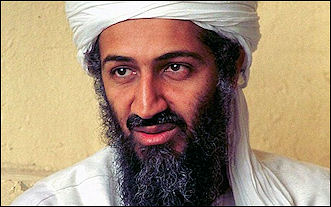
Osama bin Laden was largely seen a hands-on leader—“aggressive, audacious, but not reckless” — who was good at picking able people to do difficult jobs and who knew when to bail from a project that was too risky. Those that were close to him were required to take a personal oath directly to him. Brian Jenkins, a terrorist expert at Rand, told the Washington Post: “He is not just a mouthpiece...He comes across...as a leader reviewing proposals, putting some on the shelf, moving others into the feasibility study phase. He is thoughtful, ambitious, cold-blooded, willing to take enormous risks but at the same time scaling things back to be sure that he succeeds.”
Based evidence seized after the raid on bin Laden’s compound that resulted in his death, David Ignatius wrote in the Washington Post: “Bin Laden was a hands-on chief executive, with a role in operations planning and personnel decisions, rather than the detached senior leader that U.S. analysts had hypothesized. Zawahiri, whom the analysts had imagined as the day-to-day leader, was actually quite isolated — and remains so, despite a dozen communications this year. Zawahiri suffers from mistrust between his Egyptian faction of al-Qaeda and other operatives. [Source: David Ignatius, Washington Post, August 23, 2011]
John-Thor Dahlburg and Alex Rodriguez wrote in the Los Angeles Times: “Bin Laden's day-to-day life was described to the Observer, the British newspaper by a defecting Al Qaeda associate in June 1999. After dawn prayers, he would study the Koran and eat simple meals. Instead of using satellite phones, which he believed the Americans might use to track him down and kill him, he dictated messages to an aide, who then telephoned Al Qaeda leaders from another location. [Source: John-Thor Dahlburg and Alex Rodriguez, Los Angeles Times May 2, 2011]
“Al Qaeda apparently was tightly compartmentalized; even one of Bin Laden's top spokesmen was kept out of the loop about the Sept. 11 attacks, and some of the hijackers apparently learned only at the last moment that they wouldn't be leaving the jetliners alive....Over the years, he attracted recruits from Saudi Arabia, Algeria, Egypt, Yemen, Pakistan and other Muslim countries, and his diffuse terrorist network is said to operate in 60 nations...For his protection, Bin Laden relied on a select and devoted group of mainly Muslim fighters.”
Kate Zernike and Michael T. Kaufman wrote in the New York Times: “His foot soldiers, in testimony, offered different pictures of Bin Laden’s actual involvement. In some cases he could be as aloof as any boss with thousands of employees. Yet one of the men convicted of the bombings of the embassies said that Bin Laden had been so involved that he was the one who had pointed at surveillance photographs to direct where the truck bomb should be driven. [Source: Kate Zernike and Michael T. Kaufman, New York Times, May 2, 2011]
Osama bin Laden and the Media
Osama bin Laden was very adept at using modern media technology to convey medieval symbols and ideology. Bruce Hoffman, a terrorist expert at the Rand Corp., told the Washington Post, “He is a master impresario and manipulator of the media. There has been a consistent pattern of him making statements and issuing threats ahead of time, but not taking responsibility afterward. He alternated between the psychological campaign and acts of death and carnage.” For example, after staying out of the public eye for around two years, bin Laden popped up on Al-Jazeera, the Arab satellite televison station, in early 2001. Without taking an responsibility, he read a poem praising the suicide bombers who attacked the USS Cole in Yemen in October 2000.
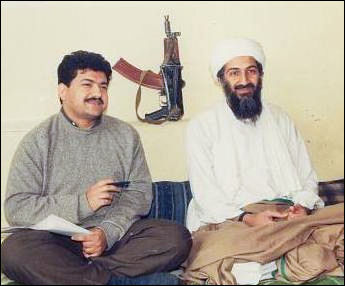
Hamid Mir interviewing Osama bin Laden
Hamid Mir, a Pakistani journalist who had interviewed bin Laden, said: Bin Laden “watches TV — CNN, BBC. I have seen with my own eyes Osama bin Laden watching CNN. I’ll tell you a very interesting thing. When I met him after 9/11, he said, “I was watching you on the Larry King show a few days ago, and you told Larry King that when Osama bin Laden talks on religion he is not convincing, but when he talks on politics he is very much convincing, so today I will convince you on some religious issues.” So I said, “O.K., you watched the Larry King show?” He said, “Yes, I am fighting a big war, and I have to monitor the activities of my enemy through these TV channels.” [Source: Peter Bergen, Vanity Fair, January 2006]
Bin Laden grew up watching plane hijackings and terrorist attacks on television. He was ten when El Al Flight 426 was jacked and 14 during the Munich Olympics. His brother Salim, a gadgets freak, kept him supplied with new technology. After Al-Jazeera was launched in 1996, bin Laden set up Al-Qaida’s production arm Al-Sahab to make regular contributions. Steve Coll wrote in The New Yorker: “Consider how bin Laden was influenced by the media coverage of airline hijackings and the murder of Israeli athletes at the 1972 Olympics. When bin Laden formed Al Qaeda, in 1988, one of its four management committees was devoted solely to media strategy. During the nineteen-nineties, in addition to self-produced videos, bin Laden recorded underground lectures on audiocassette and distributed samizdat-style revolutionary essays in Saudi Arabia by fax machine. He was not an aesthetic or intellectual innovator, but he was determined to push his radical ideas across closed borders. He passed his authority down through loose networks, and he was willing to experiment and take risks. [Source: Steve Coll, The New Yorker , May 16, 2011]
Kate Zernike and Michael T. Kaufman wrote in the New York Times: “He waged holy war with modern methods. He sent fatwas — religious decrees — by fax and declared war on Americans in an e-mail beamed by satellite around the world. Qaeda members kept bomb-making manuals on CDs and communicated through encrypted memos on laptops, leading one American official to declare that Bin Laden possessed better communications technology than the United States. He railed against globalization, even as his agents in Europe and North America took advantage of a globalized world to carry out their attacks, insinuating themselves into the very Western culture he despised. [Source: Kate Zernike and Michael T. Kaufman, New York Times, May 2, 2011]
“He styled himself a Muslim ascetic, a billionaire’s son who gave up a life of privilege for the cause. But he was media savvy and acutely image-conscious. Before a CNN crew that interviewed him in 1997 was allowed to leave, his media advisers insisted on editing out unflattering shots. He summoned reporters to a cave in Afghanistan when he needed to get his message out, but like the most controlling of C.E.O.’s he insisted on receiving written questions in advance.”
People who interviewed Osama bin Laden were blindfolded or brought in vehicles with blackened windows. They were allowed to see only the room where the interview took place and were blindfolded for the return journey. It widely believed that the vehicle that carried interviewers rode around in circles for hours and dropped the visitors not far from where they were picked up.
Al-Qaida marketed videos and books at Islamic bookstores around the world. A book of Osama bin Laden’s words became a bestseller in the Middle East. In his public pronouncements, Bin Laden rarely displayed emotion, and seldom smiled. In May 1998, Osama bin Laden held a showy news conference in the Khost region of Afghanistan in which villagers were given guns and used like Hollywood extras movie to give the impression that Al-Qaida controlled a large territory in Afghanistan. They fired shots in the air as Osama bin Laden launched to a diatribe condemning the United States and Israel.
Image Sources: Wikimedia Commons
Text Sources: New York Times, Washington Post, Los Angeles Times, Times of London, The Guardian, National Geographic, The New Yorker, Time, Newsweek, Reuters, AP, AFP, Wall Street Journal, The Atlantic Monthly, The Economist, Global Viewpoint (Christian Science Monitor), Foreign Policy, Wikipedia, BBC, CNN, NBC News, Fox News and various books and other publications.
Last updated July 2012
